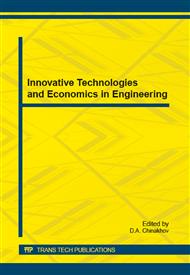[1]
S.W. Wen, P., Hilton, D.C.J. Farrugia, Finite element modelling of a submerged arc welding process, J. Materials Processing Technology, 119 (2001) 203-209.
DOI: 10.1016/s0924-0136(01)00945-1
Google Scholar
[2]
N. Murugan, V. Gunaraj, Prediction and control of weld bead geometry and shape relationships in submerged arc welding of pipes, J. Materials Processing Technology, 168 (2005) 478-487.
DOI: 10.1016/j.jmatprotec.2005.03.001
Google Scholar
[3]
M.M. Mahapatra, G.L. Datta , B. Pradhan , 3-D finite element analysis to predict the effects of SAW process parameters on temperature distribution and angular distortions in single-pass butt joints with top and bottom reinforcements, J. Pressure Vessels and Piping, 83 (2006).
DOI: 10.1016/j.ijpvp.2006.07.011
Google Scholar
[4]
D. V. Kiran, B. Basu, A. K. Shah, Three-dimensional Heat Transfer Analysis of Two Wire Tandem Submerged Arc Welding, ISIJ Intern, 51 (2011) 793-798.
DOI: 10.2355/isijinternational.51.793
Google Scholar
[5]
V.A. Sudnik, V.A. Erofeev, A.V. Maslennikov, D.V. Slezkin and R.V. Tsvelev, Mathematical model of SAW process and the phenomena in an arc cavity, Welding Int., 7 (2013) 3-12.
DOI: 10.1080/09507116.2012.753314
Google Scholar
[6]
R.V. Tsvelev, D. V. Slezkin, V.A. Sudnik, V.A. Erofeev, A.V. Maslennirov, Physical and mathematical modelling of submerged arc welding process, In VI Int. Conf. «Mathematical modelling and information technologies in welding and related processes», Katsiveli, Crimea, Ukraine, 2012, 156 - 163.
DOI: 10.1080/09507116.2012.753314
Google Scholar
[7]
J. Matsuyama, Influence of slag composition on heat transfer process in welding pool at submerged arc welding, Quarterly J. Japan Welding Soc., 4 (1986) 261-266.
Google Scholar
[8]
V.G. Kuz'menko, Determination of the temperature range of melting of the welding fluxes on the basis of the data obtained in thermal-electric analysis, Avtomat. Svarka, 9-10 (1992) 34-38.
Google Scholar
[9]
Electroslag welding and surfacing, Paton BE (Ed. ), Mashinostroenie; Moscow, (1980).
Google Scholar
[10]
D.W. Cho, W. - H. Song, M. -H. Cho, S. -J. Na, Analysis of submerged arc welding process by 3D computational fluid dynamics simulations, J. Materials Processing Technology, 213 (2013) 2278-2291.
DOI: 10.1016/j.jmatprotec.2013.06.017
Google Scholar


